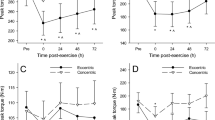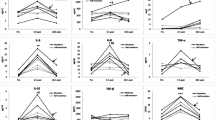Abstract
Unaccustomed, eccentrically biased exercise induces trauma to muscle and/or connective tissue. Tissue damage activates an acute inflammatory response. Inflammation requires the effective interaction of different physiological and biological systems. Much of this is coordinated by the de novo synthesis of families of protein molecules, cytokines. The purpose of the present paper was to determine changes in blood levels of various cytokines in response to exercise-induced muscle damage that was effected using high-intensity eccentric exercise. Six healthy, untrained, college-age male subjects were required to perform the eccentric phase of a bench press and a leg curl (4 sets, 12 repetitions/set) at an intensity equivalent to 100% of their previously determined one-repetition maximum. Samples of blood were drawn at the following times: before exercise and 1.5, 6, 12, 24, 48, 72, 96, 120, and 144 h after exercise. These samples were analyzed for interleukins (IL): IL-lβ, IL-6, and IL-10; tumor necrosis factor-α; colony stimulating factors (CSF): granulocyte-CSF, macrophage-CSF, and GM-CSF; for cell adhesion molecules (CAM): P- and E-selectin, and intercellular cell adhesion molecule (ICAM-1), and vascular cell adhesion molecule (VCAM-1). Results were analyzed using a repeated-measures analysis of variance (P=0.05). Compared to baseline values, IL-1β was reduced (P=0.03) at 6, 24, and 96–144 h after exercise; IL-6 was elevated (P=0.01) at 12, 24, and 72 h after exercise; IL-10 was elevated (P=0.009) between 72 and 144 h after exercise; M-CSF was elevated (P=0.005) at 12 and 48–144 h after exercise; and P-selectin was reduced (P=0.01) between 24 and 144 h after exercise. It is concluded that when high-intensity eccentric exercise is compared to strenuous endurance exercise, post-exercise changes in cytokines do occur, but they are generally of a smaller magnitude, and occur at a later time period after the termination of exercise.
Similar content being viewed by others
Author information
Authors and Affiliations
Additional information
Accepted: 28 December 1999
Rights and permissions
About this article
Cite this article
Smith, L., Anwar, A., Fragen, M. et al. Cytokines and cell adhesion molecules associated with high-intensity eccentric exercise. Eur J Appl Physiol 82, 61–67 (2000). https://doi.org/10.1007/s004210050652
Issue Date:
DOI: https://doi.org/10.1007/s004210050652




